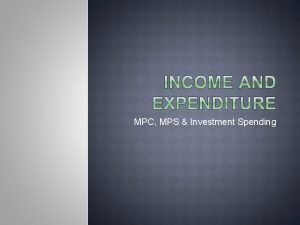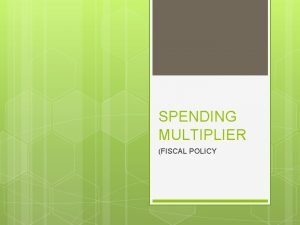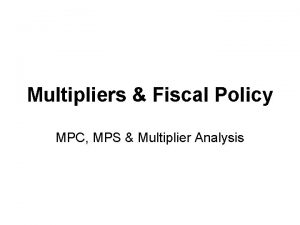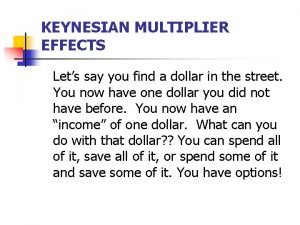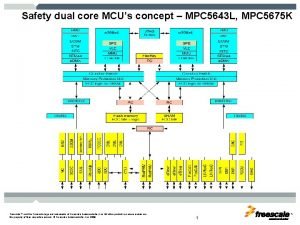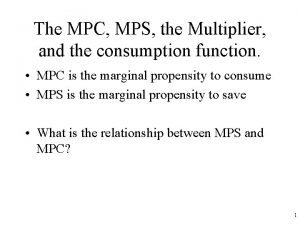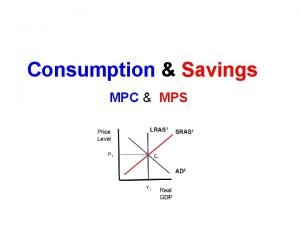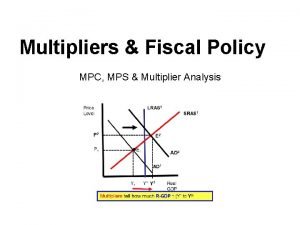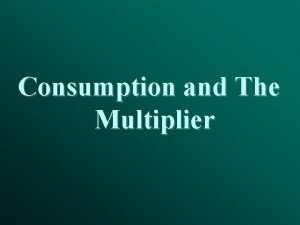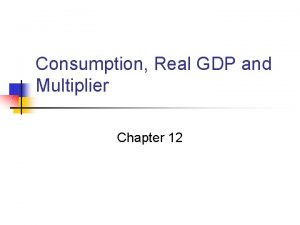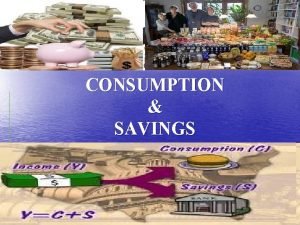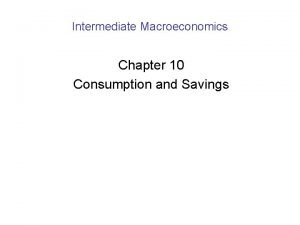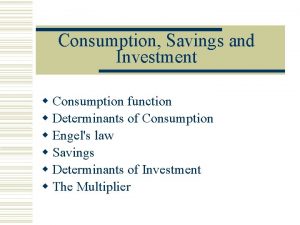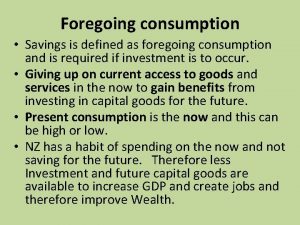Consumption Savings MPC MPS Multiplier Analysis 2 Methods



















- Slides: 19

Consumption & Savings MPC, MPS & Multiplier Analysis

2 Methods to Calculate GDP • Expenditure Method: GDP = AD = C + I + G + NX • Income Method GDP = Y = wages + interest + rents + profits • Both methods yield same result: EXPENDITURE = INCOME

SPENDING = INCOME Y = AD = Real GDP Income or Aggregate Output Y = INCOME S = SAVINGS Spending or Aggregate Expenditure C = CONSUMPTION

Disposable Income (DI) • What consumers have left over after taxes – DI = Gross Income – Net Taxes • With no Government taxes or transfers: – DI = Consumption + Savings [S] FIRMS Consumption [C] HOUSEHOLDS Aggregate Income [Y]

Consumption • Consumption is a function of disposable income (DI) DI C

Marginal Propensity to Consume • Slope of the consumption function is the marginal propensity to consume (MPC) MPC = ∆C / ∆ DI

Savings & Dissavings 45% line Savings Dissavings

Consumption Function • Autonomous Consumption – there is a minimum amount of consumption person (people will beg, borrow or steal to consume) Disposable Income • C = 40 +. 80 (DI) Consumption [C] Savings [S] 0 40 -40 100 120 -20 200 0 300 280 20 400 360 40 Autonomous Consumption Marginal Propensity Consume DI => C $100 $80

Savings • Savings = DI – Consumption ( S = DI – C ) • MPS = ∆S / ∆ DI • MPC + MPS = 1 fraction of income consumed fraction of income saved Must be true because everything not saved is consumed: DI = C + S

Savings Function • Autonomous Savings----Savings can be negative since consumption is never zero • S = -40 +. 20 (DI) Disposable Income Consumption [C] Savings [S] 0 40 -40 100 120 -20 200 0 300 280 20 400 360 40 Autonomous Savings Marginal Propensity Save DI => S $100 $20

Changes in Consumption & Savings • Changes in disposable income cause movements along the consumption & savings function • Changes in these 4 -factors cause shift in each function – Wealth – Expectations – Household Debt – Taxes & Transfers

Taxes & Transfers: Only item to shifts savings & consumption function in same direction Taxes C Taxes S

Worksheet: Part 1 MPC & MPS 45% line Savings Have students complete #1 -#8 on handout Dissavings

Stop Here: Block Period

Investment & Gov’t Spending Multiplier • Multiplier = ∆GDP / ∆ Gov’t Spending • MPC & MPS determine investment or spending multiplier • 2 -ways to calculate multiplier: • Multiplier = 1/(1 -MPC) Example: MPC =. 80 or (if you know MPC & MPS) 1/MPS 1/(1 -. 80) = 5

Multiplier • Spending & investment have a “multiple” affect on GDP Government raises spending $100 If MPC =. 80 PRODUCT Market Change in GDP: FIRMS HOUSEHOLDS FACTOR Market Round 1 $100. 0 Round 2 $80. 0 Round 3 $64. 0 Round 4 $51. 2 Etc…. .

The Tax Multiplier • Multiplier = ∆GDP / ∆ Taxes • Is always smaller than spending/investment multiplier • TM = -MPC * (spending multiplier) • Example: $200 tax cut Example: or -MPC/MPS MPC =. 80 TM = -. 80 * 5 = -4 1/(1 -. 80) = 5

Balanced Budget Multiplier • Always equal to 1 (regardless of MPC) • Assume Government ↑ Taxes & ↑ Spending – By same $ amount – MPC =. 90 Example: Spending Multiplier = 10 Tax Multiplier = 9 Always a difference of 1

Multiplier Worksheet
 Mpc calculation
Mpc calculation Mpc mps
Mpc mps Mpc multiplier calculator
Mpc multiplier calculator Multiplier mps
Multiplier mps A-wax pattern recognition
A-wax pattern recognition Meertalige professionele communicatie studeren
Meertalige professionele communicatie studeren Swagelok mpc
Swagelok mpc Mpc nursing program
Mpc nursing program Mefe ejemplo
Mefe ejemplo Spending multiplier
Spending multiplier Ria mpc
Ria mpc Mpc trnava
Mpc trnava Mpc ap macro
Mpc ap macro Hybrid mpc
Hybrid mpc Hybrid mpc
Hybrid mpc Mpc library database
Mpc library database Mpc košice
Mpc košice Manufacturing planning and control
Manufacturing planning and control Master mpc
Master mpc Mpc5643
Mpc5643

